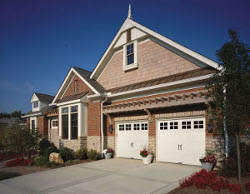
Supersize is no longer a trend in our meals or in our homes.
In the post-recession era of the “frugal-istas,” residential square footage is declining and so are consumer requests for home theaters, multi-car garages and in-law suites. Buyers still want a high-quality home, they just want it in a smaller package.
One casualty of the new economy has been the “garage mahal.” The number of homes built with three-car garages peaked in 2005 and is now on the decline. Residential garage door manufacturer Clopay estimates that the number of homes being built with three-car stalls will drop from 25% to 15% by 2012, transforming the status of the three-car garage from a standard new construction feature into an upscale or custom build amenity.
But other trends in the building industry are keeping the garage door front and center as
builders and homeowners search for practical and profitable solutions that exemplify quality over quantity.
Despite having fewer of them, garage doors are becoming a bigger part of the home’s façade than they were before. Cost is one driving factor. Side-load garages are more expensive to build, hence garage doors are returning to the front of the home. Shrinking lot sizes and elevations are making front-entry garages the only solution for builders trying to maximize usable living space.
As a result, builders are focusing on affordable, designer garage doors like the Clopay Gallery® Collection to help differentiate their homes against others built in the same neighborhood just two or three years ago.
Although comparable in price to traditional raised panel garage doors, subtle details on the Gallery line like grooved panels, decorative hardware and windows, give buyers the perception of a higher-end home.
“Garage doors are a major exterior design feature, especially when the garage faces the street,” says Marty DeWald, a real estate veteran with a 20-year track record as a top producer for ReMax Unlimited in Southwest Ohio. “An upgrade doesn’t necessarily cost a lot but it makes a big first impression, considering 73 percent of Americans now enter their home through their garage.”
In a nationwide survey conducted by Stratamark Research and Clopay Building Products, real estate agents said that upgrading the garage doors on a home can increase the asking price by up to four percent.
Garage door energy efficiency is going to become even more important as home sizes get smaller. To maximize living space builders will have no choice but to put bedrooms or recreational space above the garage. Since attached garages typically share one or two common walls with the house, any hot or cold air that travels through the garage door will ultimately reach the living areas adjacent or above.
“With today’s rising energy costs, investing in an insulated garage door can be just as valuable as upgrading to energy efficient appliances, entry doors and windows elsewhere in your home,” says Pat Lohse, Clopay Building Products vice president of residential marketing. “Insulated garage doors help keep utility costs down, and they have a huge impact on the comfort of the garage which is increasingly used for more than storage.”
And with home sizes decreasing, homeowners’ quest for additional living/recreational space is once again leading them to the final frontier of remodeling – the garage. According to Big Book of Garages author Tina Skinner, the garage is increasingly becoming an extension of the home – doubling as a mudroom, garden center, or even a workshop. “And in many cases, it’s becoming a convenient place where people of all ages can gather to simply hang out,” she says.
A dramatic shift in how homes are designed, built, maintained and lived in has occurred. While the real estate bubble burst may have shone a bright white light on the fact that bigger isn’t always better, it didn’t hinder consumers’ ability to make smarter choices about the products they choose to invest in, to make sure they are getting the most “bang for their buck” in terms of innovation, value, curb appeal and energy efficiency.